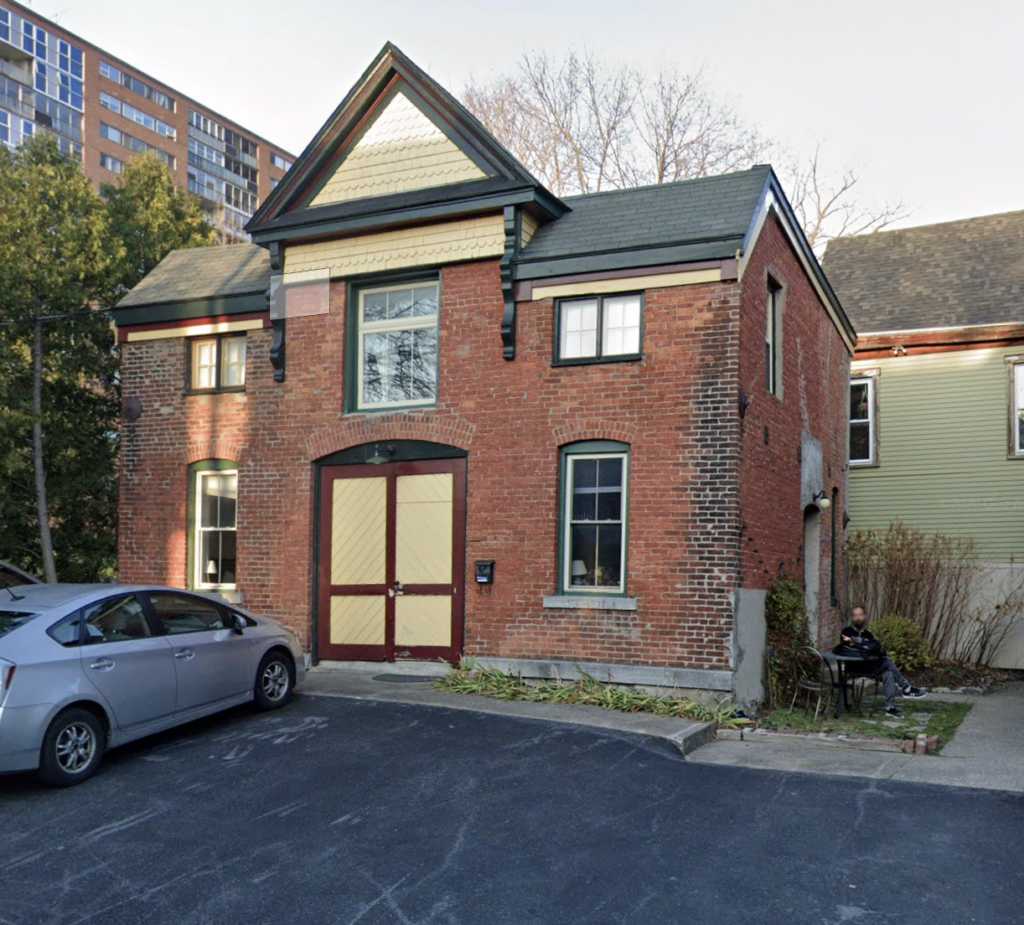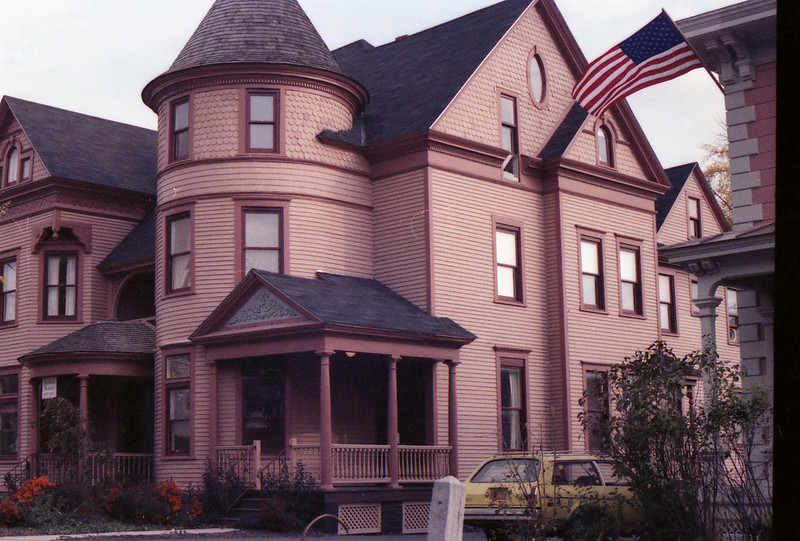Going Back, Part Three: Seneca
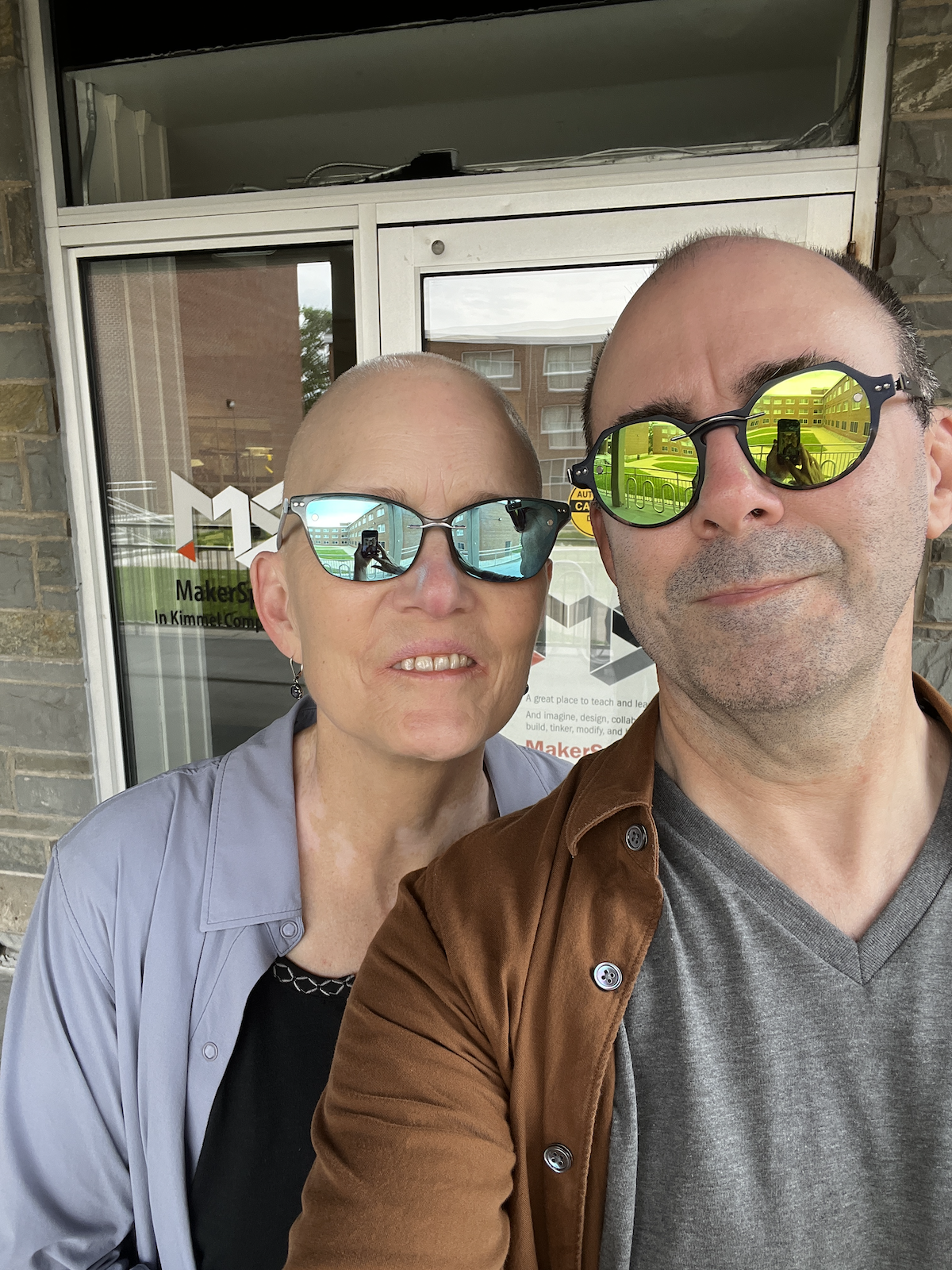
By all rights, this account of one residential location, for one semester, should be the shortest of my memories stimulated by our recent visit to Syracuse (see Part One and Part Two). And yet:
Back in the fall of 1979, our sophomore year return to Day Hall was something less than triumphant – or at least, it didn’t echo the experiences and friendships of our first year there. Most of our old friends were off the Mount, and more and more of life seemed to revolve around the northern end of campus – certainly all of my life at the Daily Orange did. (I’ll need to talk about the DO completely on its own, another time.) So Danny and I decided to put in for a transfer for the spring semester and see where that landed us. Our preference was what was called “Village” housing, a very random collection of old houses and apartment buildings mostly on the north end of campus and beyond, in various states of repair. We hadn’t heard anything when we left for Christmas break (my last), so assumed nothing had been done with it and we’d live out the rest of sophomore year in Day Hall.
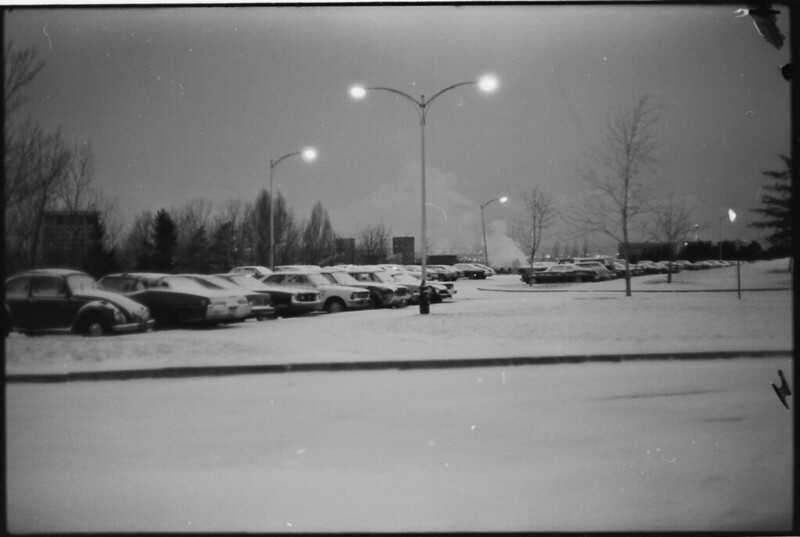
I left for break for Christmas break with a case of pneumonia that had sidelined me from my finals. At first indistinguishable from my normal and frequently severe asthma, I plowed through with my overly extended schedule and less than restful lifestyle for as long as I could into December of 1979, and then all of a sudden I couldn’t breathe without severe pain. Lee got me down to the student health service, where the waiting room was filled with students looking to get out of finals, and I was seen by a doctor with the demeanor of Nurse Diesel, a doctor who was absolutely sure I was faking just to get out of my exams, a doctor whose disappointment was palpable when the lung x-ray showed a pretty serious case of pneumonia. I went home sick, and remained that way for most of the break. I do not remember how I got home, though it’s likely my father came and drove me back home. When it was time to return to school, I also don’t remember if I got a ride back to Syracuse or took the bus.
I can’t stress enough that in those days, if our parents drove us to school, they just dropped us off. For some people, there was probably a meal together at Phoebe’s Garden Cafe (still going strong, and I have still never been there), then a drive up to the dorm, and maybe they’d slow down while you got out of the car. There were no lingering visits, no parents wandering into the dorms. (Well, some did, but it was unnerving.)
I don’t even recall how I got back to campus that time but I suspect Greyhound, which would have left me a lonely mile and a half walk away from the dorm. Yes, there were taxis, but the bus trip had already cost me at least $8 (I seem to recall it was $12 round trip, but these numbers could be wrong). I wasn’t gonna blow another $2-3 on the last mile and a half.
It’s likely I don’t remember because I was still pretty sick, not nearly fully recovered. I know Danny’s parents drove him in from Bennington, because we instantly regretted that a car, which we desperately needed, was no longer available to us. I don’t remember which of us got there first, probably Danny, but when we got to our room in Day Hall, it wasn’t our room anymore. Staff had taken all our stuff and crammed it into a study room called the Day Hall Library. In our mailboxes, we found postcards that told us that our new accommodations would be in Seneca Hall, just about a mile away. It was completely on us to figure out how to make that happen but we were welcome to sleep in the library that night. Yes, they mailed our new dorm assignments to the dorm – the dorm that was completely closed during the break.
Oy to the vey.
It’s fortunate I was on staff at The Daily Orange at the time, because the DO had a van, and borrowing the van, which was absolutely not allowed, was a constant feature of life in those days. So the next day I was able to perform an unauthorized borrowing of the van, and we lugged our stuff down to the Seneca Apartments.
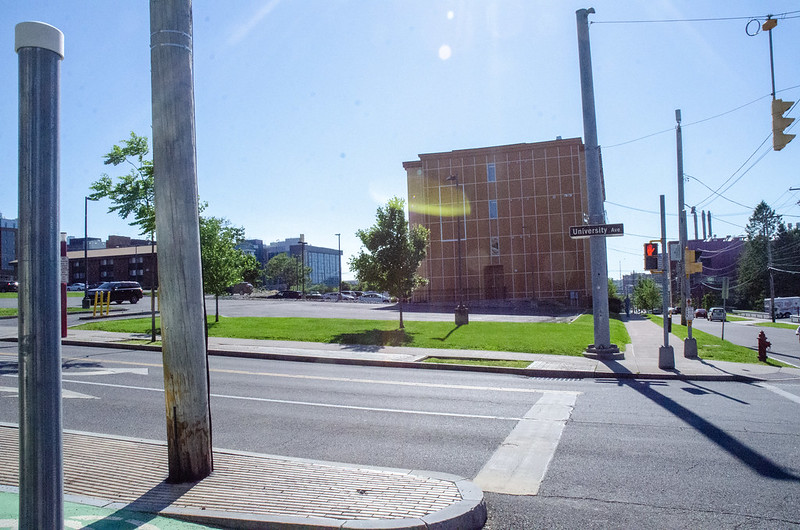
Seneca was a once very nice apartment block at 600 University Avenue, at the southwest corner of Harrison, and the northernmost residence hall. It was on a block with a couple of similar buildings as well as some independently owned frame apartment buildings, across from an open parking field and some other wooden frame buildings used as offices by SU. Today, Seneca doesn’t even rate a listing on the “Lost Buildings of SU” page, so I can’t find a picture of what it looked like, when it was built or when it was demolished. I know that in the late ’60s and early ’70s it was a women’s residence hall, but by the time we were there it was coed. The apartments were arranged as suites, so we were placed in with two other roommates – Danny and I had a good sized private room to ourselves, and our other two roommates had their own rooms. There was no kitchen or other common space besides the bathroom, but it was pretty decent and more spacious than Day Hall had been. It was also our first cross-cultural experience at SU, with an Algerian roommate named Salim who was a charming disco devil.
Being on that edge of campus changed our dining options, eating more often at Kimmel or Haven dining halls than we would have otherwise. Lee was still living in Booth, which was also now closer by.
Jabberwocky
We were also closer to Jabberwocky, the legendary student nightclub located in the basement of Kimmel Dining Hall. The Jab requires a serious digression.
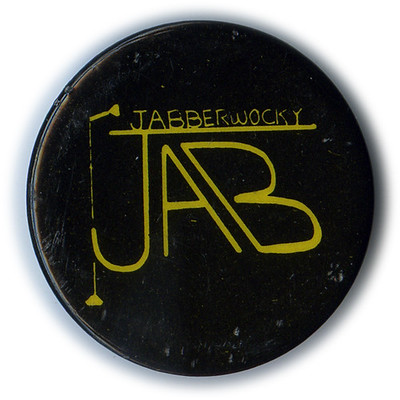
I don’t think I discovered Jabberwocky, even though it was a constant haunt of my DO colleagues, until my second semester at SU, but from then on, it was the focus of our musical and social lives. I was there too late to say I’d seen Talking Heads before they were famous, as so many others claimed, but it was a source of constant cutting edge entertainment. Yes, we saw The Ramones there, more than once, as well as Flo and Eddie, Ed Sanders of The Fugs, Larry “Bud” Melman, and who knows who else. But while it was cool that the club was booking acts like New York Dolls, it was really an important venue for the incredible local music scene that was going on in the late ’70s and early ’80s, with bands like The Flashcubes, Screen Test, 1.4.5., The Most, Pop Tarts, The Tearjerkers, Dress Code, maybe The Trend, and many, many more. It introduced students to non-student bands, and gave us some of the greatest nights of our lives.
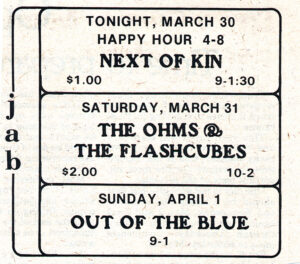
When I think of the hours we spent pogoing inside that small, sweaty club, excited beyond belief to be bouncing along to the beat as The Flashcubes closed with a Beatles raver like “Dizzy Miss Lizzy” or “Money.” We’d spill out into the night, for once grateful for the cool air, and trip down the hill in search of a Zorba’s sub, a 2 AM meal that would put me into a coma today. Whatever Johnny Zorba did to make his oven-toasted sandwiches, they were tasty beyond belief.
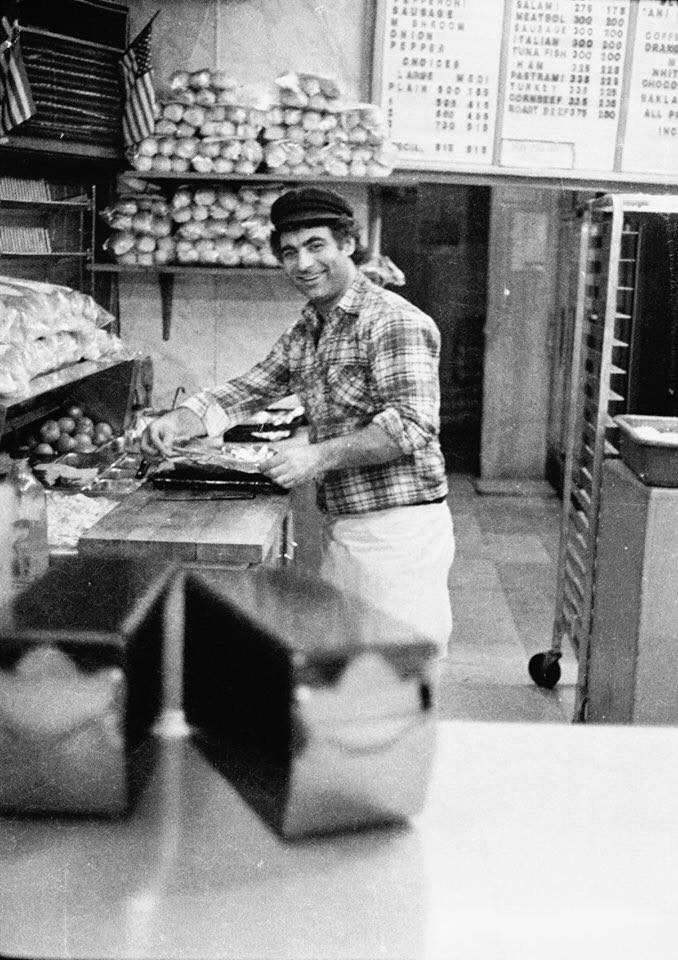
The Jab also featured disco night, oldies night, Friday happy hours, the ill-advised Sunday happy hour, and even the occasional movie showing – it’s where we first saw “Rock ‘n’ Roll High School.” So I couldn’t begin to guess how much time I spent there. All of it. When Danny came out to help us celebrate our 40th anniversary last year, I specifically put a song by The Standells, “Rari,” on the playlist – and to my delight, he remembered exactly why. It was because we spent more than a few nights yelling at the oldies night DJ, desperately trying to get him to play “Rari,” the flip side of “Dirty Water,” because it is a goddam raver and we knew our friends would dance to it. He absolutely would not. He played “Dirty Water” every single time. But I’m telling you right now, go listen to “Rari.” You’d have danced.
The Jab remained an essential part of the campus experience until the drinking age was raised to 21, at which point a student club that really pushed the Long Island iced teas suddenly didn’t make sense, so it closed in 1985. The final weekend featured James Brown, which didn’t make any sense to me (since the club had been so integral to New Wave, and not at all to soul/funk/RnB) so I didn’t go even though it was James Brown. It would have been a sad nostalgia trip anyway, and not shared with any of my friends, who had all moved on from Syracuse at that point. John Cale apparently played the actual final show, a night later, but I’m not sure I was even aware of that. It would have been interesting, if only because his former partner Lou Reed had lived just across the street in Watson Hall for at least part of his Syracuse life.
While I was attending grad school, the Jab had been turned into a computer lab, one which I sometimes used (students didn’t yet have their own computers then), and it couldn’t have been weirder to sit in that space trying to work on a database project while thinking of the hours we had spent dancing there. There wasn’t a trace of the previous incarnation left, naturally. It was long thought that the Lewis Carroll-inspired murals on the back wall, which had given the Jab its name, had been lost, but I’m happy to report they were saved and conserved! They were, for a time, on display in Bird Library – but apparently they were off display when we were there. I’d have cried if I’d seen them again, I can tell you that.

Back to Seneca
The spring semester of 1980, the dawn of a new decade spent at Seneca, was, to my memory, cold and wet even by Syracuse standards. Snow gave way to rain, but in March and April, there was precipitation nearly every day. It didn’t matter much – students gotta move, so move we did. When we were in our room, less sound-proof than Day Hall had been, we were more quietly listening to Tommy James and the Shondells, The Ramones’ “End of the Century,” Pat Benatar. And, of course, still and always, The Beatles.
Journalistically, I was very happy, doing a lot of layout, proofreading and pasteup, though giving a really poor showing as a special projects editor (daily pressure works much better for me than occasional pressure). Socially, I was doing great. Academically, I was doing okay. Alcoholically, things were still relatively in control, but it was a very short walk to the little beer stores on M Street like Students’ Choice Foods, or the cheap Friday afternoon pitchers at the Varsity, etc., etc. The wheels hadn’t come off yet.
I said I was doing okay academically – the truth is, I never really recovered from the flurry of incompletes I had to take the previous semester as a result of the pneumonia. Projects had to be made up and submitted, exams had to be taken, and in at least one case, I just gave up and failed the class. I was carrying a heavy course load for that spring semester, and still working what amounted to a full-time job at The DO, supplementing my pay with late night/overnight pasteup sessions that paid $15 a shot but sometimes didn’t have me returning home until 2 or 3 a.m., or actual dawn on some occasions. I was burning the candle at both ends, as well as in the middle. It was all a colossally bad idea, especially for someone who’d recently been so sick. But I believed in little more than my own invincibility and lack of need for sleep.
When I think of Seneca, I think of how dark and rainy it was all the time. I remember a lot of launching off to parties or the Jab from there, in the dark and the wet. I remember crushing heat from the radiators, waking up in the night absolutely parched and desperate for something to drink, which was often a can of Coke. Water wasn’t really in our vocabulary at that point. I think of wandering down to Nabil’s little grocery store for milk and his proclaiming “Drink beer! Is cheaper!” Not that I needed the encouragement, as he no doubt knew.
That was also the semester that Lee and I had our first and only class together, which we sometimes cut for reasons our kids won’t want to read about. We were young and very in love. Not as much as now, but still.
As was and still may be standard at colleges, we were required to live in campus-owned housing for the first two years, and then we could be on our own. Upperclass students who chose to live in university housing were almost universally housed on South Campus, a relatively modern complex of decent apartments call Skytop that was located about a mile and a half away – a distance that would never have worked for either of us, who routinely had to work into the middle of the night.
So we found the path of least resistance and decided to relocate to a small but affordable studio apartment in a building catercorner from Seneca – the distances to everything would be the same, the cost would be significantly lower, and while the space was nothing great, Danny and I had been coexisting in small spaces for two years already and were pretty good at it. Because this building was popular with foreign students, we dubbed it The Embassy. Lee would move there, too, in her own apartment, so we’d be living in the same building again. We’ll get to that next time. But for now I’ll just note that there is no longer even a trace of Seneca, or any of the buildings that were near it on that block, or across the street. Everything is gone. But The Embassy, a sad little ’60s vintage block of nothing – that still stands.
Going back – well, standing in front of the spot where Seneca had been brought no particularly strong feelings – if anything, I felt the loss of 602-1/2, a neighboring apartment building where friends lived and where I spent the entire summer after Seneca hanging out, much more acutely.
But standing again outside what was once the Jab, the little courtyard that stands behind Marion Hall and that led on the other side to Toad Hall (a different apartment building than the one currently with that appellation) and down the hill – the visceral memory of spilling out of the crash doors at the Jab at the end of the night, gulping the bracing cold air, – so excited, so full of life, so goddamn young.
The Jab itself has long been gone – and now Kimmel and its neighbor Marion are slated for demolition, so before long it’ll be hard to say where it even was. I’m glad we got to stand in that space again and remember for a few minutes what it was to be so young.



